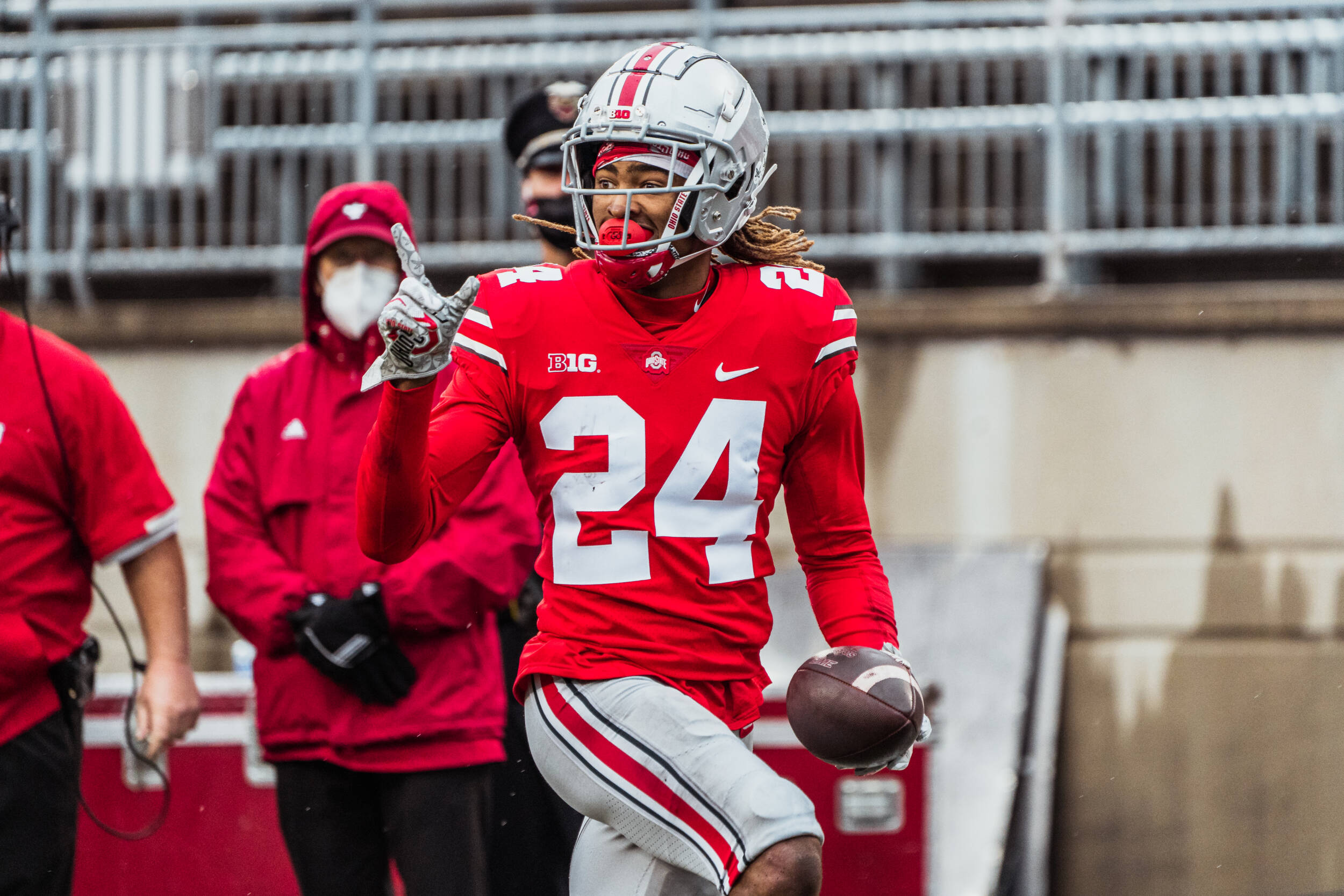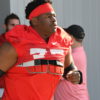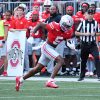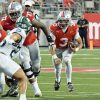
Hey, that was fun, right? Okay, maybe Ohio State’s 42-35 victory over a surging Indiana program, complete with a furious second half comeback bid from the Hoosiers wasn’t quite as enjoyable for Buckeye fans (or Hoosier fans) as it was for a neutral observer, but to see Ohio State tested by a Big Ten foe has been a rarity in recent season.
Penn State was the lone regular-season battle for the Buckeyes in 2019 that felt anywhere near dangerous for Ohio State and it frequently looked as though OSU would go completely unchallenged in 2020, with the Nittany Lions and Wolverines both struggling mightily. That Indiana, one of the most interesting programs in America right now, was able to give the Buckeyes a real fight is valuable and exciting, even if Ohio State fans may not be feeling that way, given the playoff and national title aspirations of this program.
It was valuable primarily because this served as the first and possibly the only instructive game of the regular season. Questions about the Buckeye pass defense and offensive line were answered in a way that Ryan Day likely won’t enjoy seeing, while other potential weaknesses, like the rushing attack, rose to the occasion when called upon. In a season without nonconference games and in a very down Big Ten, seeing Ohio State play a team with a pulse was tremendously important to evaluating where the Buckeyes are relative to the other national powers competing for a playoff spot.
Unfortunately for those Buckeyes, the evaluation is not especially generous, specifically on the defensive side of the ball. After a strong first half showing, Ohio State allowed 28 points to the Hoosier offense in the last 26 minutes of the game, on drives of 75, 60, 75 and 56 yards respectively. Indiana exploited a struggling secondary with big plays, so it wasn’t as though Ohio State was being gashed constantly underneath as it had been against Penn State, and the Buckeye run defense was admittedly outstanding, but yardage is yardage, regardless of where it’s coming from.
“Good news is, we obviously stopped the run,” Day said. “There was no run game at all, it was all passing. So yeah, going to go back, watch the film and kind of figure out where these issues are that are creating these big plays. Because when you stop with the big plays, then you’ll be in pretty good shape. But that’s a part of playing great defense, and we got to get that changed.”
When Day goes to look at the film, he’ll likely run into one primary issue that this defense has been facing throughout the season, though it was truly exposed for the first time on Saturday. Simply put, the personnel in the Buckeye secondary does not match the scheme that Kerry Coombs wants to run.
That isn’t to say that Ohio State’s defensive backs are without hope, nor is it to say that Coombs is in too far over his head to ever succeed as a defensive coordinator, even if it may not be in Columbus, depending on how the next few weeks go and how patient Day plans to be. There is talent in this backfield and it’s hard to believe that a group of former four-and five-star prospects is just completely incapable of playing football.
No, the easier explanation and the one that honestly requires a lot less introspection for the Buckeyes given that the alternative would require a significant shift in recruiting strategy – is that there’s a disconnect between what Coombs is asking and what these players are capable of doing. The scheme is not 2018 levels of bad and the players are not 2019 levels of good, both of which are certainly worth noting and could contribute to a step back, but when both of those issues are combined, you get, well, this.

Whether you think the defensive issues are devastatingly, season-endingly bad or just boilerplate, standard bad, that’s not an easy stat line to look at for the Silver Bullets. That indicates an issue to put it kindly.
That issue is that Buckeye defenders in the secondary are pretty frequently out of position, for essentially no reason. It happens in man and it happened here in a Cover-3 look, once of the staples of Jeff Hafley’s defense that worked so well for the Buckeyes in 2019.
OSU drops into a deep three-shell with Sevyn Banks and Shaun Wade manning the outside thirds, while Marcus Hooker drops into the center of the field. Underneath, the linebackers and Josh Proctor, filling the slot corner role, drop into a wide four-man shell with a focus on the inner half of the field to prevent a quick hitter underneath, which burned the Buckeyes against Penn State and Rutgers.
All of that is fine. Wade does his job, as do the linebackers, while the does an acceptable job of pressuring Michael Penix. Sevyn Banks is a bit too aggressive and gets beaten, which you really don’t want out of a look like this. Those deep-third defenders can’t have receivers running behind them.
Banks isn’t exclusively at fault though, because he’s left completely without help in the deep center of the field where the ball actually goes. Hooker bailed on that third to cover an intermediate dig route for essentially no reason, because Tuf Borland is doing an excellent job of tracking that receiver and keeping him in check. Hooker doesn’t need to be there, and he’s caught there because he’s relying too much on his eyes and not enough on following his assignments.
He’s not the only one. Here, Ohio State is in man with a single-high deep safety. This either wasn’t communicated to Teradja Mitchell or wasn’t clear to someone else on the defense, because Mitchell covers the receiver for about five yards and then allows him to pass, as if Ohio State is again running that Cover-3 look with a deep third. It isn’t and there’s no one back there to cover the wideout.
“We had a couple blown coverages,” Wade said. “The one with 10 outside, that was a blown coverage. There were a couple, we just had blown coverages and sometimes they just make a play. That’s a part of playing football. Receivers going to make plays, DBs going to make plays.”
Now, it is worth noting that if the call here was actually for Mitchell to cover an outside receiver in man coverage, Coombs should take that play call and put it in the trash can. Given that this wasn’t the only instance of an outside linebacker in coverage on an outside receiver, that seems likely.
Similar idea here and pretty much the exact same result. Ohio State is in man, this time with two-high safeties to counter a five-wide receiver look in an obvious passing down. Pete Werner and Baron Browning are both put into man coverage underneath, with Werner drawing (and managing) a tight end while Browning gets the unenviable task of covering David Ellis, a fast wide receiver, despite Browning being… a linebacker.
“The one instance where they ran the little mesh route and No. 10 (David Ellis) got in the end zone – a little miscommunication between me and the safety on that,” Browning said of this play. “The pass game in general, we’ve got some things we can clean up. But I feel like each week we’re getting better in that area and that’s all that matters. How can we be better than we were last week in the passing game and just overall as a defense?”
That may be an understatement. Browning gets caught up and looks for help from Hooker, who comes in too far to help Banks, a job that should fall to the boundary safety, Proctor, who doesn’t appear to be doing anything at all on this play. Hooker should step up to follow Ellis across the field once he sees Browning caught and would have been able to prevent a first down had he followed that read correctly. Putting Browning in man coverage here is a bad choice and a flaw in the defense (Proctor is right there, just put him in coverage and take Browning off the field for a sixth defensive back), but this is still preventable with better safety play.
That’s the general takeaway from this game. There are distinct scheme issues that can likely be attributed to Coombs not quite understanding the limitations of his players and those players often look confused by the actual play call, like on this look, where Indiana shows bunch and Ohio State runs… something? There’s not actually a distinct shape here. Every defender seems to be running his own defense. It’s also true that players like Wade, Banks, Marcus Williamson and Hooker are struggling even on plays that they run correctly and there doesn’t seem to be an immediate answer for that issue, given that Proctor can only replace one player (which should be Williamson). There’s blame to be taken by all parties here.
But ultimately, that doesn’t do much to solve the problem that Ohio State is in here. Coombs isn’t likely to change the scheme significantly, though it doesn’t feel as though cutting some of the trickier coverage would be especially difficult. The players aren’t likely to suddenly grasp these concepts. There aren’t reinforcements coming. This may just be what this Buckeye defense is. Is that enough to seriously contend for a national title?








